|
|
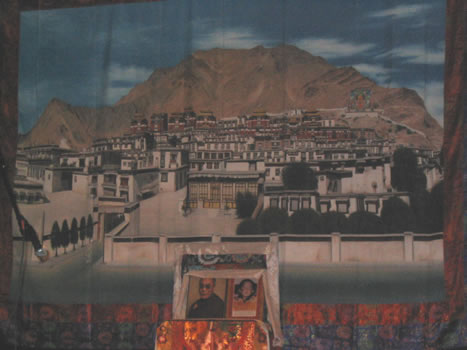 |
Since the Tashi Lhunpo monks are touring North America to raise awareness for the plight of the Panchen Lama, they took a few opportunities to tell us about him throughout the events we saw. The Panchem
Lama (Panchen is short for Pandita Chenpo meaning Great
Scholar), GedunChoekyi Nyima, was born April 25, 1989, was chosen by the Dalai Lama to be the Panchen Lama on May
13, 1995, and was then kidnapped by the Chinese Government on May 17, 1995. He has not been seen or heard from since. Soon after the Chinese government kidnapped him, they brought out a child that THEY claim is the true Panchen Lama and tried to have him accepted by the Tibetan people.
|
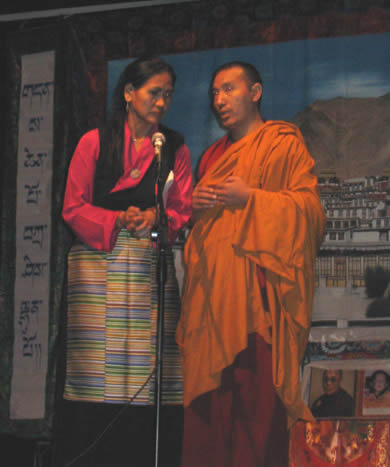 |
|
Several of my friends have asked me why there is all this fuss about this and why it matters so much, why would China kidnap a 6 year old child? Well, it seems the Dalai Lama and the Panchen Lama have an age-old system going where one of them is young while the other is old. That way, when the older one dies, the younger one is around to make the decision as to who the new incarnation is. So if China has a puppet Panchen Lama under their control, when the Dalai Lama dies and is incarnated again, the idea is that the Chinese Government controlled Panchen Lama will choose a Chinese approved Dalai Lama and then all Tibetans will basically be under Chinese control. I hope and think that this plan will not work though because the Tibetans will not accept the puppet Panchen Lama.
Another interesting thing I learned form the cham was that the Panchen Lama is an incarnation of
Amitabha, who was the spiritual father of Avalokiteshvara (who the Dalai Lama is an incarnation of). Really quickly, Avalokiteshvara is a
bodhisattva who wanted to rid the world of all suffering. He told his spiritual father, Amitabha this and said that if he couldn't do it, he would explode himself into a thousand pieces. So he sat and meditated and sent compassion out into all realms of existence.
|
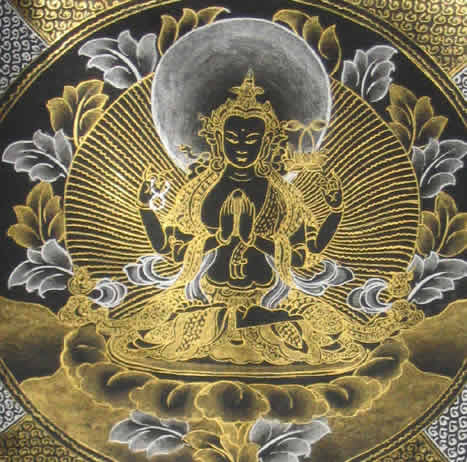 |
|
He ridded the realms of suffering three times and then turned to Amitabha and told him that he had done it. So Amitabha said to turn around and look again..... Avalokiteshvara did and saw the realms filled again with human suffering, so true to his word, he exploded himself. Amitabha felt sorry and knew that the job was too big for a normal person, and so put Avalokiteshvara back together again, but this time gave him 1000 arms, each with an eye in the palm so he could see everywhere and have enough hands to help people, and gave him 11 heads so he could see in all directions at once. Among his 11 heads are 9 normal ones, one wrathful one named Mahakala, and one like Amitabha himself. Avalokiteshvara is known as the Buddha of Compassion, and the Dalai Lama is the incarnation of him.
|
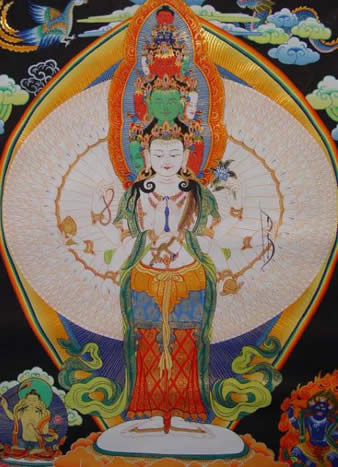 |
|
To start the cham off, the monks came to the front of the stage and did
Semkye. This is where the chant and pray to the deities to
free all living beings from all forms of suffering. |
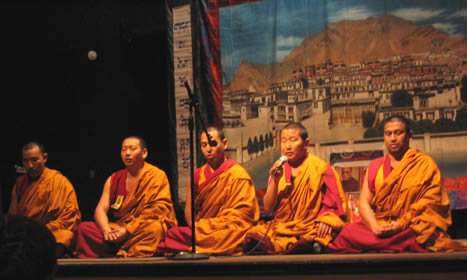 |
|
Next was a dance called Shama. This was a
dance between a stag and a buffalo. It represents two
aspects of truths. One or the other of these is a
representation of Manjushri, who is another bodhisattva, the Bodhisattva of wisdom. In paintings he is always shown with a book on his shoulder, and a flaming sword (remember the flaming sword form the mandala?) which he uses to free the mind of bonds and illusions. Also, Manjushri is supposed to have been the one to cut a pass in the Himalayas so that a great lake could drain, forming the
Katmandu valley.
Also, he is also thought of as an
incarnation of Amitabha (remember him? Panchen Lama is an
incarnation of Amitabha.) The dance is accompanied with
music from the drum, horns and cymbal.
Click
here to download a video clip of the Shama dance.
After the Shama, the monks next came out and did
Kunkik, which is a
lovely prayer full of hand mudras. It is said that just by
watching this, people will have a better rebirth. The handle
of the bell that they ring in this (which I pointed out in the
peace mandala photos) has a person wearing a crown, and it is this
crown that the monks are wearing in this. The Tashi Lhunpo
Monastery is known for it's hand mudras. |
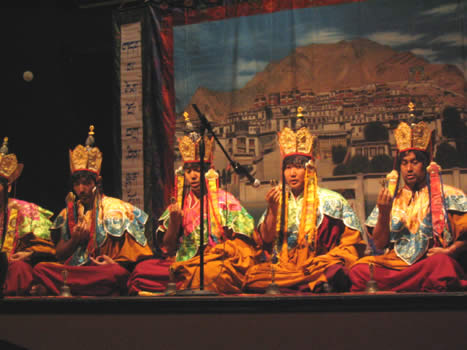 |
|
Dur Dak, The Dance of the Skeletons came
next. I think these skeletons represent Chitipati, the Lords
of the Charnel Ground in Thangka paintings. Again, the dance
was accompanied by horns, drum and cymbal music.
Click
here to download a short video clip of the Dance of the
Skeletons.
|
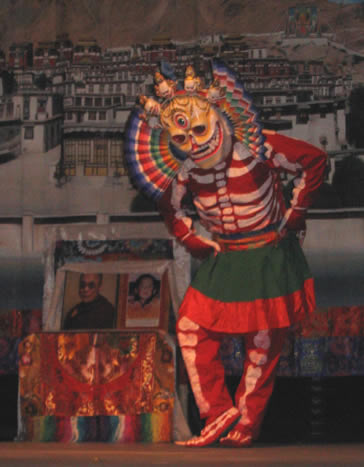 |
|
The next dance was called Bak Nyi, and it was a
dance between Yamantaka and another Bodhisattva. Yamantaka
is one of my favorite of the wrathful deities of Tibetan
Buddhism. Yamtaka is the wrathful emanation of Manjushri
(you may notice a trend forming here!). The story is that a yogi was meditating in a cave and had been for years. He was one day from attaining enlightenment, when some cattle
thieves came into his cave with a stolen buffalo. They killed it by cutting off it's head, but then noticed the yogi. They decided to kill him by cutting off his head so they would not get caught despite his pleading with them not to kill him. Since he was one day from attaining enlightenment, and was not allowed to do
that because of having his head cut off, he became so angry that he leapt up, grabbed the
buffalo head and stuck it on his own headless body. The combination of his anger and his spiritual progress caused him to assume the form of Lord Yama, the God of Death. He immediately killed the cattle thieves and then went on a rampage killing all he came across. The people pleaded with Manjushri to help, so Manjushri assumed a buffalo headed form much like this new version of Yama, but much fiercer and was able to scare
Yama to death by showing him the interconnectedness of all. This emanation
of Manjushri was then known as Yamantaka, the defeater of death.
Here is a shot of Yamantaka:
|
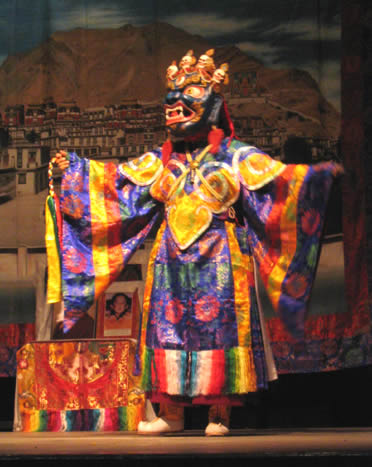 |
|
|
|
|
|
|
|